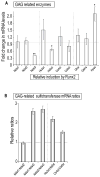The osteogenic transcription factor Runx2 regulates components of the fibroblast growth factor/proteoglycan signaling axis in osteoblasts
- PMID: 19259985
- PMCID: PMC2918404
- DOI: 10.1002/jcb.22108
The osteogenic transcription factor Runx2 regulates components of the fibroblast growth factor/proteoglycan signaling axis in osteoblasts
Abstract
Heparan sulfate proteoglycans cooperate with basic fibroblast growth factor (bFGF/FGF2) signaling to control osteoblast growth and differentiation, as well as metabolic functions of osteoblasts. FGF2 signaling modulates the expression and activity of Runt-related transcription factor 2 (Runx2/Cbfa1), a key regulator of osteoblast proliferation and maturation. Here, we have characterized novel Runx2 target genes in osteoprogenitors under conditions that promote growth arrest while not yet permitting sustained phenotypic maturation. Runx2 enhances expression of genes related to proteoglycan-mediated signaling, including FGF receptors (e.g., FGFR2 and FGFR3) and proteoglycans (e.g., syndecans [Sdc1, Sdc2, Sdc3], glypicans [Gpc1], versican [Vcan]). Runx2 increases expression of the glycosyltransferase Exostosin-1 (Ext1) and heparanase, as well as alters the relative expression of N-linked sulfotransferases (Ndst1 = Ndst2 > Ndst3) and enzymes mediating O-linked sulfation of heparan sulfate (Hs2st > Hs6st) or chondroitin sulfate (Cs4st > Cs6st). Runx2 cooperates with FGF2 to induce expression of Sdc4 and the sulfatase Galns, but Runx2 and FGF2 suppress Gpc6, thus suggesting intricate Runx2 and FGF2 dependent changes in proteoglycan utilization. One functional consequence of Runx2 mediated modulations in proteoglycan-related gene expression is a change in the responsiveness of bone markers to FGF2 stimulation. Runx2 and FGF2 synergistically enhance osteopontin expression (>100 fold), while FGF2 blocks Runx2 induction of alkaline phosphatase. Our data suggest that Runx2 and the FGF/proteoglycan axis may form an extracellular matrix (ECM)-related regulatory feed-back loop that controls osteoblast proliferation and execution of the osteogenic program.
Figures








Similar articles
-
The heparan sulfate proteoglycan (HSPG) glypican-3 mediates commitment of MC3T3-E1 cells toward osteogenesis.J Cell Physiol. 2009 Sep;220(3):780-91. doi: 10.1002/jcp.21825. J Cell Physiol. 2009. PMID: 19479939
-
Runx2 regulates G protein-coupled signaling pathways to control growth of osteoblast progenitors.J Biol Chem. 2008 Oct 10;283(41):27585-27597. doi: 10.1074/jbc.M802453200. Epub 2008 Jul 14. J Biol Chem. 2008. PMID: 18625716 Free PMC article.
-
The regulation of runt-related transcription factor 2 by fibroblast growth factor-2 and connexin43 requires the inositol polyphosphate/protein kinase Cδ cascade.J Bone Miner Res. 2013 Jun;28(6):1468-77. doi: 10.1002/jbmr.1867. J Bone Miner Res. 2013. PMID: 23322705 Free PMC article.
-
Regulation of Skeletal Development and Maintenance by Runx2 and Sp7.Int J Mol Sci. 2024 Sep 20;25(18):10102. doi: 10.3390/ijms251810102. Int J Mol Sci. 2024. PMID: 39337587 Free PMC article. Review.
-
Regulation of Proliferation, Differentiation and Functions of Osteoblasts by Runx2.Int J Mol Sci. 2019 Apr 4;20(7):1694. doi: 10.3390/ijms20071694. Int J Mol Sci. 2019. PMID: 30987410 Free PMC article. Review.
Cited by
-
Genomic promoter occupancy of runt-related transcription factor RUNX2 in Osteosarcoma cells identifies genes involved in cell adhesion and motility.J Biol Chem. 2012 Feb 10;287(7):4503-17. doi: 10.1074/jbc.M111.287771. Epub 2011 Dec 9. J Biol Chem. 2012. PMID: 22158627 Free PMC article.
-
Parathyroid hormone/parathyroid hormone-related peptide regulate osteosarcoma cell functions: Focus on the extracellular matrix (Review).Oncol Rep. 2016 Oct;36(4):1787-92. doi: 10.3892/or.2016.4986. Epub 2016 Aug 1. Oncol Rep. 2016. PMID: 27499459 Free PMC article. Review.
-
Synergism between Wnt3a and heparin enhances osteogenesis via a phosphoinositide 3-kinase/Akt/RUNX2 pathway.J Biol Chem. 2010 Aug 20;285(34):26233-44. doi: 10.1074/jbc.M110.122069. Epub 2010 Jun 14. J Biol Chem. 2010. PMID: 20547765 Free PMC article.
-
Concise Review: Multifaceted Characterization of Human Mesenchymal Stem Cells for Use in Regenerative Medicine.Stem Cells Transl Med. 2017 Dec;6(12):2173-2185. doi: 10.1002/sctm.17-0129. Epub 2017 Oct 26. Stem Cells Transl Med. 2017. PMID: 29076267 Free PMC article. Review.
-
Proteomic Profiling of the Human Fetal Multipotent Mesenchymal Stromal Cells Secretome.Molecules. 2020 Nov 12;25(22):5283. doi: 10.3390/molecules25225283. Molecules. 2020. PMID: 33198321 Free PMC article.
References
-
- Bae JS, Gutierrez S, Narla R, Pratap J, Devados R, van Wijnen AJ, Stein JL, Stein GS, Lian JB, Javed A. Reconstitution of Runx2/Cbfa1-null cells identifies a requirement for BMP2 signaling through a Runx2 functional domain during osteoblast differentiation. J Cell Biochem. 2007;100:434–449. - PubMed
-
- Bodo M, Baroni T, Carinci F, Becchetti E, Bellucci C, Conte C, Pezzetti F, Evangelisti R, Tognon M, Carinci P. A regulatory role of fibroblast growth factor in the expression of decorin, biglycan, betaglycan and syndecan in osteoblasts from patients with Crouzon’s syndrome. Eur J Cell Biol. 1999;78:323–330. - PubMed
-
- Bonaventure J, El GV. Molecular and cellular bases of syndromic craniosynostoses. Expert Rev Mol Med. 2003;5:1–17. - PubMed
-
- Boudreaux JM, Towler DA. Synergistic induction of osteocalcin gene expression: identification of a bipartite element conferring fibroblast growth factor 2 and cyclic AMP responsiveness in the rat osteocalcin promoter. J Biol Chem. 1996;271:7508–7515. - PubMed
Publication types
MeSH terms
Substances
Grants and funding
LinkOut - more resources
Full Text Sources
Research Materials
Miscellaneous

